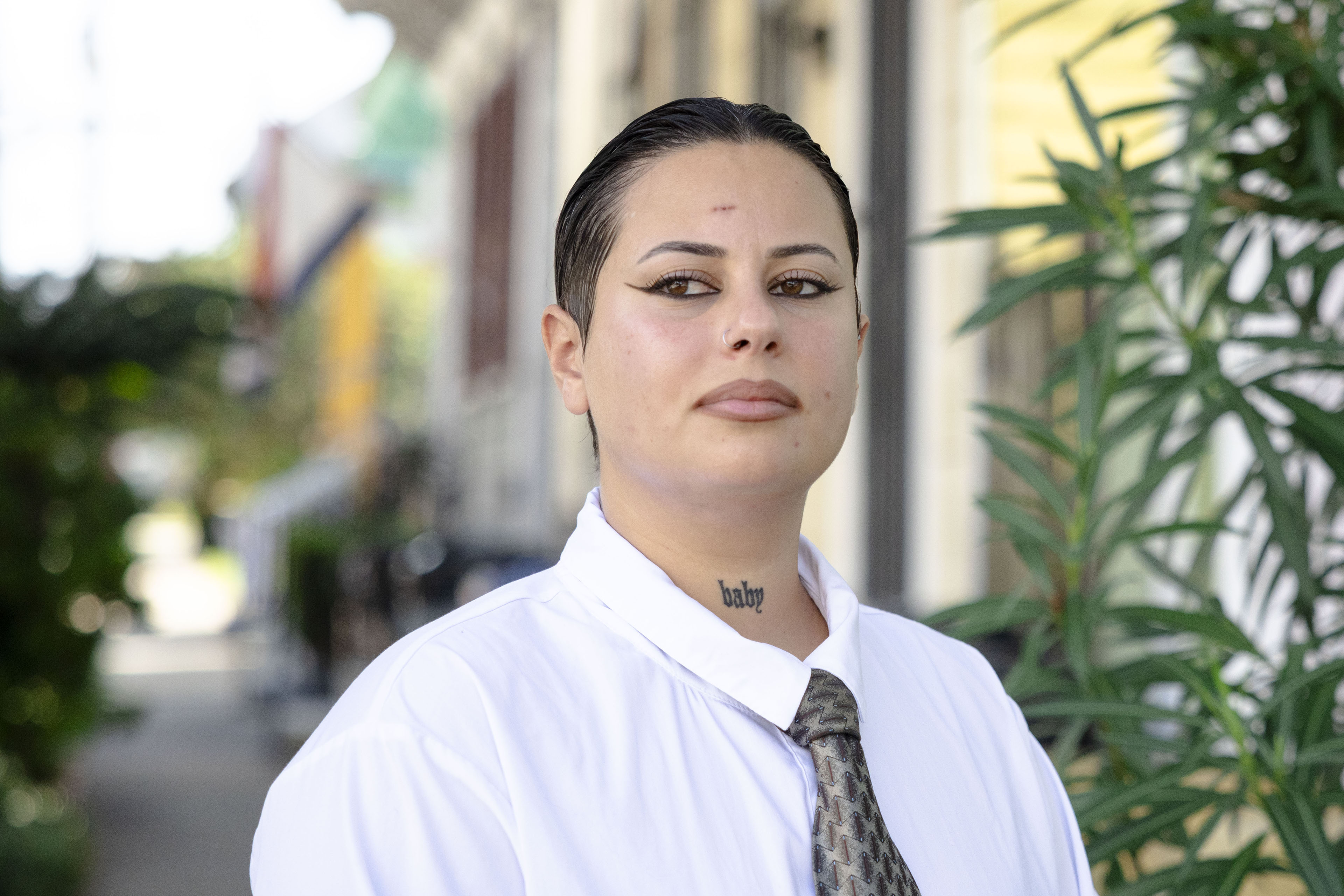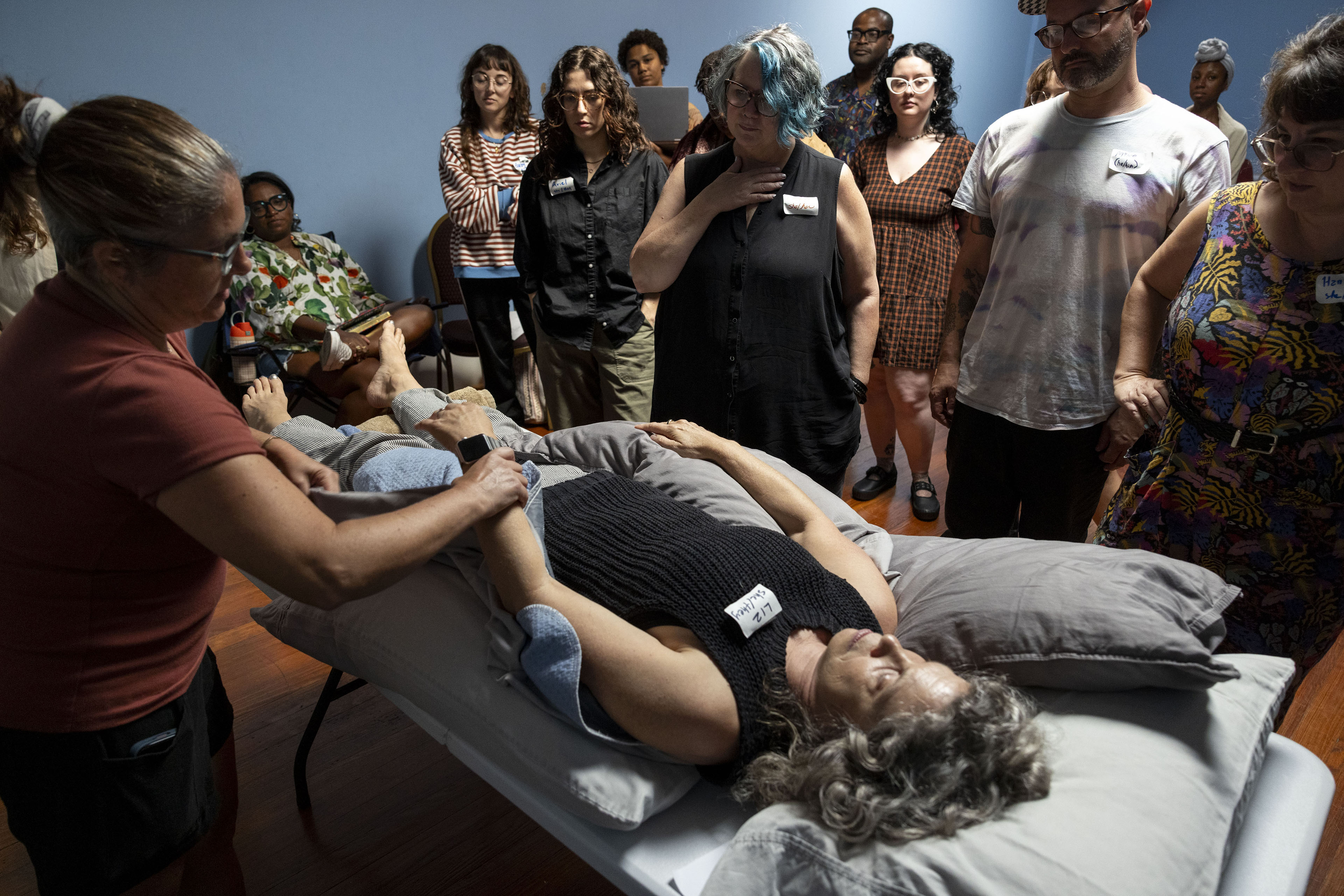Liz Danneback isn't dying, but at a recent senior care seminar in New Orleans, she pretended to die.
Dannebak lay motionless on a folding table, which was designed as a bed, and complained that her legs hurt. Registered nurse Ana Kanellos rolled up two small white towels and demonstrated how to elevate ankles to relieve pain.
“Are mommy's feet always swollen? Lift them up,” Kanellos said.
About 20 New Orleanians listened intently, eager to learn more about how to care for loved ones at home as they near the end of their lives. Visitor Alix Vargas said she used to be afraid of death. But about three years ago, the death of a close relative prompted her to attend group writing workshops that helped her accept her grief and conquer her fear.
“I feel very called to this work,” she said. “It's definitely knowledge that I wanted to gain and expand my horizons in this way. And it's also something that we will all encounter in our lives.”
The workshop got her thinking about a neighbor whose mother has dementia.
“I immediately thought, 'OK, there's someone in my immediate area who is experiencing this,'” Vargas recalls. “Here’s a practical way to put mutual aid to work.”
Demand for home health care, including home hospice care, has increased dramatically since the start of the Covid pandemic, as has the number of family caregivers. An estimated 63 million people in the United States—nearly a quarter of all American adults—provided care for another person with a disease or disability, usually another adult, in the past year, according to 2024 survey AARP and National Alliance for Caregiving. Over the past 10 years, about 20 million more people have become caregivers.

With nearly one in five Americans expected to be 65 or older by 2030, health experts predict that the demand for in-home caregivers will continue to grow. Online end-of-life care resources are widely available, but hands-on training to prepare people to become caregivers is lacking and can be expensive. However, untrained family members-turned-caregivers take on the work of care and health care.
Donald Trump promised more support for caregivers during his 2024 campaign, including a promise to create new tax breaks for those who care for family members. He supported a bill reintroduced in Congress this year that would allow family caregivers to receive tax credits of up to $5,000, but the bill never moved forward.
Meanwhile, Medicaid cuts expected under the Republicans' One Big Beautiful Bill, which President Trump signed into law in July, could prompt states seeking to offset their additional costs to reconsider participation in additional state Medicaid programs, such as the one that helps pay for health care services. hospice care at home. That threatens to make dying at home even more unaffordable for low-income families, advocates and researchers say.
Advocates like Osha Towers are trying to help caregivers navigate the uncertainty. Towers spearheads LGBTQ+ inclusion effort WITHcompassion and choicea national organization dedicated to improving end-of-life care, preparation and education.
“It's obviously very scary, but we know what we can do right now is just show up in front of all the people to make sure they know what they need to be prepared for,” Towers said.
In New Orleans a non-profit organization called Wakewhich supports family caregivers providing end-of-life and end-of-life care, is one organization trying to help fill the knowledge gap. Wake organized a free three-day workshop in September in which Danneback, the group's founder, pretended to be a dying patient. These workshops aim to prepare participants on what to expect when loved ones die and how to care for them, even without expensive professional help. Complete home care is rare.
“No special training is required to do this job,” Danneback said. “You just need some skills and support to make it happen.”

Lori Dietrich, Wake's program manager, answers questions about the dying process and home care during the nonprofit's September workshop. (Christiana Botik/Verite News and CatchLight Local/Report for America)

Danneback (center), founder of Wake, helps provide end-of-life care training at the Healing Center. (Christiana Botik/Verite News and CatchLight Local/Report for America)
In some ways, the evolution of elder care in the United States has come full circle over the last century. It wasn't until the 1960s that people moved from dying at home to dying in hospitals, nursing homes and hospices.
Such facilities can provide immediate advanced medical support and palliative care to patients, but they often lack the human interaction that home care provides, says Laurie Dietrich, Wake's program manager.
Now more and more people want to die at home, among their families, but with the support and technology that is available in modern medical institutions.
Doulas, who support the non-medical and emotional needs of dying people and their loved ones, have grown in popularity over the past decade as they guide people through the dying process, helping to fill this gap. Douglas Simpson, Executive Director International End of Life Doula Associationsaid his organization recognizes the lack of resources for end-of-life care, so it trains doulas to become community educators. He hopes that doulas can be especially helpful in rural communities in facilitating conversations about death.
“Making people more open, more comfortable talking about death and considering their own mortality,” Simpson said.
Death doula training varies depending on the organizer, but Simpson's group focuses on teaching participants about the dying process, how to maintain a dying person's autonomy, and how to be mindful of coming to work and caring for themselves while caring for others.
Some of the people who attended Wake's workshop had also attended some form of death doula training in the past. After Nicole Washington's mother was murdered in 2023, she considered becoming a death doula. But she believes doula training, which can cost anywhere from $800 to $3,000, was clinical and impersonal, in contrast to Wake's community-based approach.
“I feel very energized and inspired,” Washington said. “It’s also really nice to be around people who are familiar with death and grief.”
Ochsner Health's Susan Nelson, who has worked as a geriatrician for 25 years, said there is a need for more specialized programs to educate and train caregivers, such as Wake's program.
“Unfortunately, learning nursing skills is probably another trial by fire,” Nelson said.
Compassion & Choices is another organization trying to educate caregivers. Towers said the group's training ranges from advanced planning to serving as a spokesperson for health care and end-of-life care.
“We've gotten to a place in our country where we're as disconnected from elder care as we used to be,” Towers said.
Towers said the home care and community support movement has its roots in the AIDS epidemic, when some doctors refused to care for AIDS patients. Friends, especially lesbian communitybegan coordinating meal delivery, visitations, bedside vigils, and even touch circles where patients could receive calming forms of touch, such as hand-holding, to relieve pain and feelings of isolation.
“I like to look at this as a model of what we can get back to now, which is just prioritizing public assistance again,” Towers said.

This article was prepared in collaboration with Believe News. Verite News reporter Christiana Botik contributed to this report.
[Correction: This article was updated at 1:30 p.m. ET on Nov. 25, 2025, to correct Osha Towers’ pronoun usage.]







